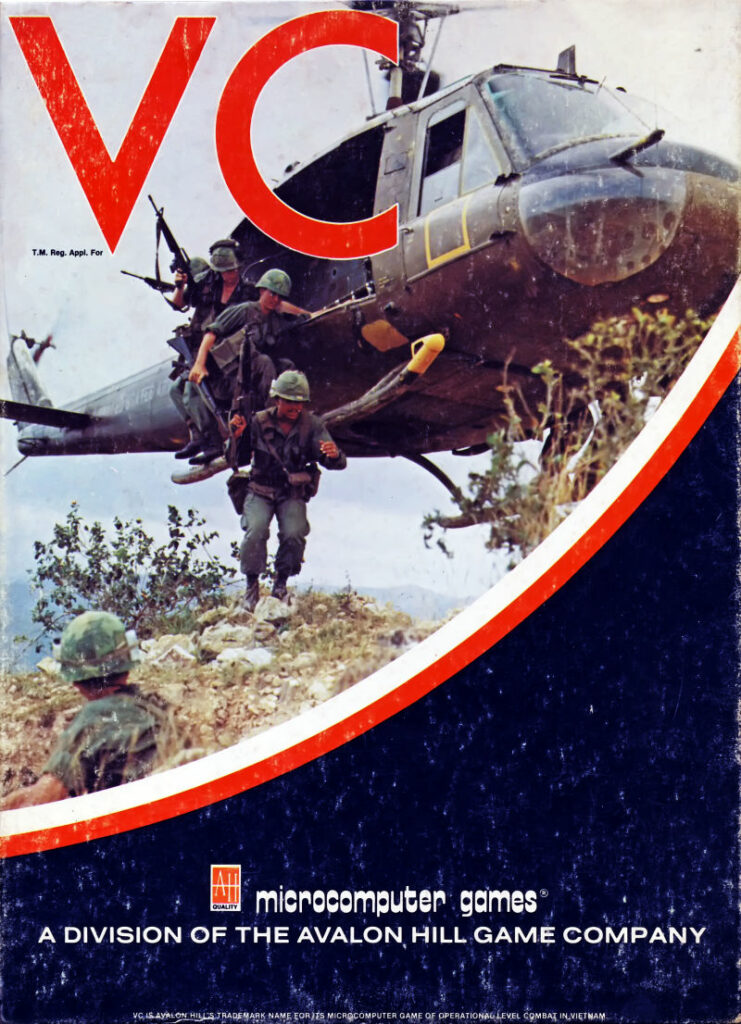
Lieutenant Narwhal, you found the Bismarck, and then, against all odds, you found the Graf Spee ! You have been identified by the… uh, higher-ups, as someone good at finding things.
Well, thanks Sir ! What do they want me to find this time, Sir ? I suppose it is the Deutschland this time, isn’t it ?
Oh, no. This time you will not exactly be looking for ships…
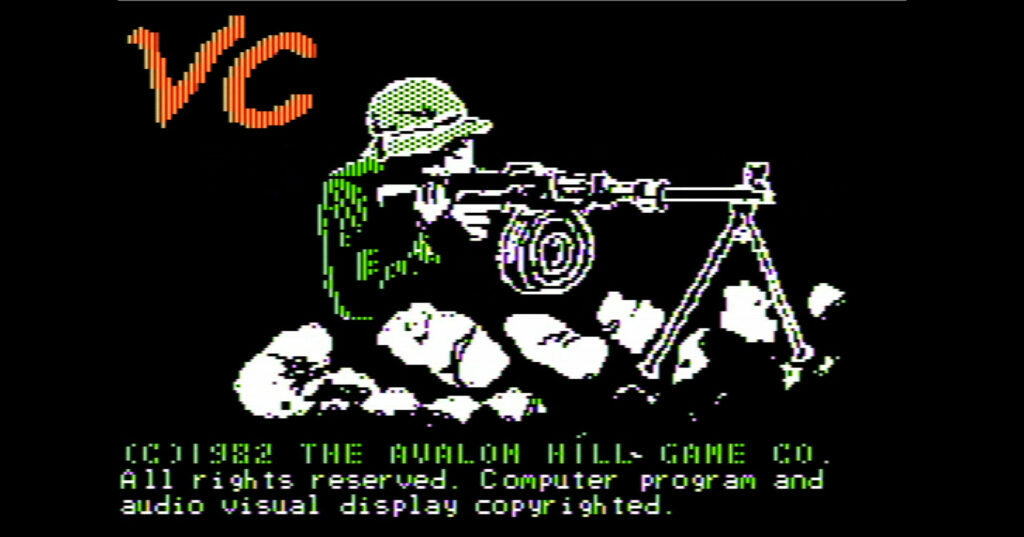
VC is one of six games from the “fall 1982” batch of Avalon Hill, which includes :
- an ambitious adventure game : G.F.S. Sorceress
- a forgettable and forgotten arcade game : Moon Patrol, not to be confused with the way more important 1983 Moon Patrol by Irem (Japan), the game that first introduced full parallax scrolling. No fewer than seven arcade games had been released by Avalon Hill earlier in 1982,
- a weak RPG : Telengard,
- three wargames
- Andromeda Conquest, already covered
- Chris Crawford’s Legionnaire,
- VC, today’s game,
VC‘s theme stands out, as it was “Avalon Hill’s first game ever on the controversial Viet Nam war“, a war that had ended only 7 years prior. It was a risky move : in his 1980 Complete Book of Wargames, Jon Freeman describes bluntly the challenge faced by tabletop designers trying to cover the Vietnam war : “Its immediacy and relevance demand attention but the subject repels players : games from Viet Nam to Year of the Rat have been uniformly unpopular and have remained in print only briefly. The style of warfare waged in Vietnam did not offer much scope for the sort of large-scale armor engagements valued so highly in modern wargames. Conventional battles were few and little known to the public. […] Simulating the entire conflict is next to impossible. [Guerilla warfare] has never been properly – or successfully- simulated, [they] are as much political affairs as military actions. This combination has so far defeated the best efforts of designers.“
Quite a challenge then for the unproven designer Britt Monk, whose only other game would be 3-D Brickaway in 1983, a 3D version of Breakout. Spoiler : given the technical limitations of 1982, he survives the trial honourably.
The game starts with the player controlling a mixed force of South Vietnamese [ARNV for Army of the Republic of Vietnam] and Americans. :
- 10 ARNV infantry battalions, initialy worth 3 in strength,
- 1 US Airmobile infantry battalion, initially worth 5 in strength, but it will drain down over time,
- 1 US Artillery battalion,
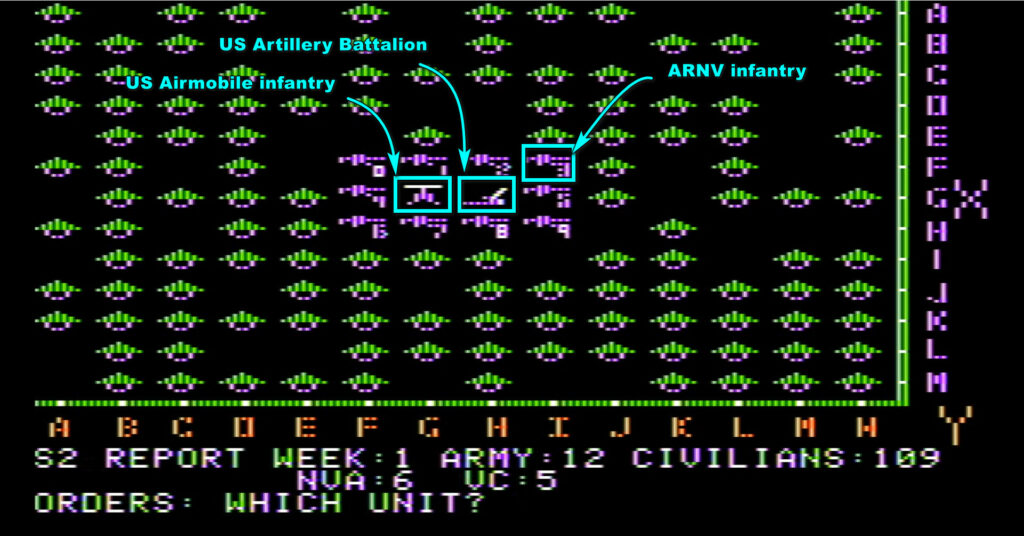
Surrounding this force, presumably situated in a camp in the middle of Vietnam, a sea of civilians, among which are dissimulated North Vietnamese regular forces (NVA) and South Vietnamese insurgents: Vietcongs (or VC).
Well, time to send some ARNV troops to chat with the locals!
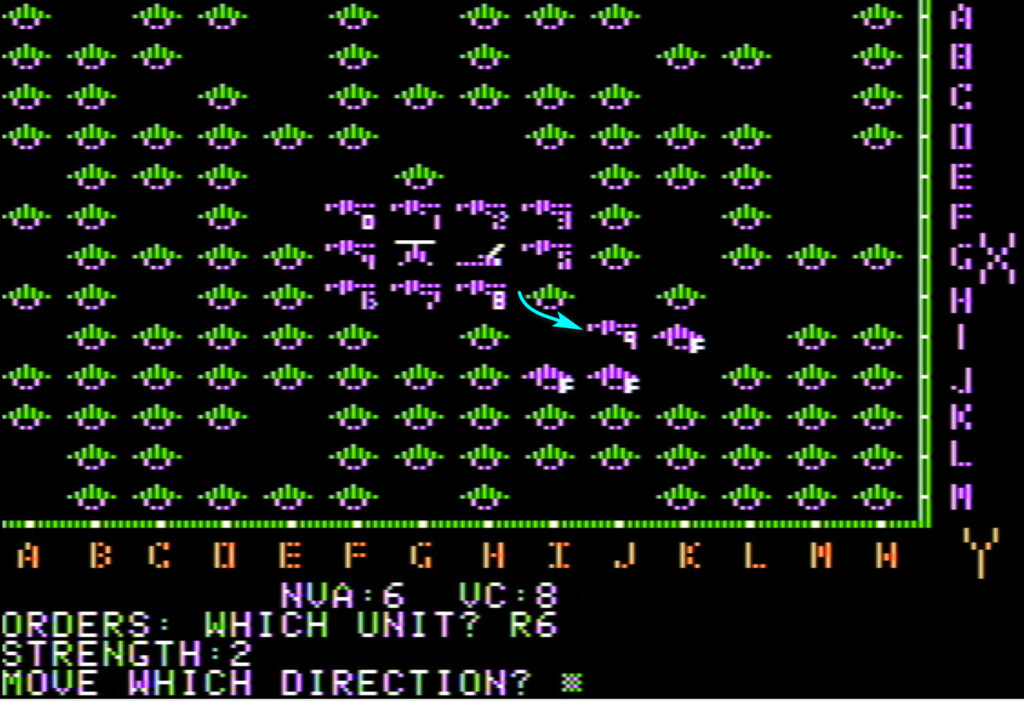
When an ARNV unit moves in contact to “neutral” civilians, it will do two things :
- They will engage any VC or NVA hidden among the civilians – but I don’t find any in this case,
- They will convince some of the neutral civilians to join what is obviously the correct side of history. If they do, the civilians are then displayed in pink with a little F. When VC and NVA later encounter these friendly civilians, they will have to kill them or at the minimum will only be able to turn them back to neutral (instead of recruiting them), this way signaling their presence.
My next investigation in the South-West is less peaceful : my 6th ARVN battalion finds a VC group and some elite NVA forces. They fail to destroy the NVA, but the US artillery does the job. Immediately after, some VC try to attack my perimeter, but they are crushed by ARVN battalion #2
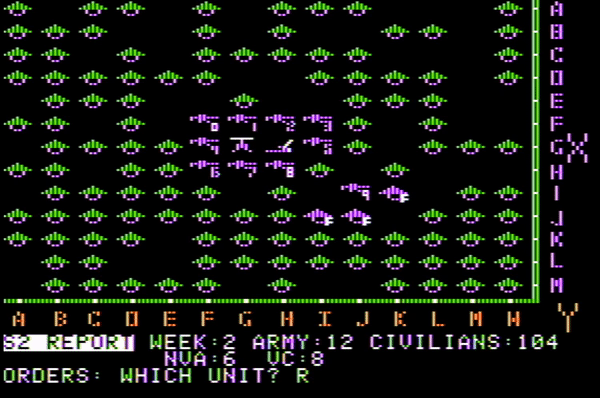
That’s 3 communist units removed, but I am still racing against time : there were 5 VC units at the beginning of the game, but there are now 14 of them so their recruitment is going steady : every time a VC unit moves next to a neutral civilian group they have a chance of turning it into more hostile VC. And of course, most movements are invisible, except when some unit moves to a hitherto empty tile.
At least, the Reds cannot recruit the much stronger NVA – their only unit with a good chance of destroying my ARNV infantry.
The following turn, an offensive patrol in the North West finds another NVA unit, which is also destroyed by artillery :
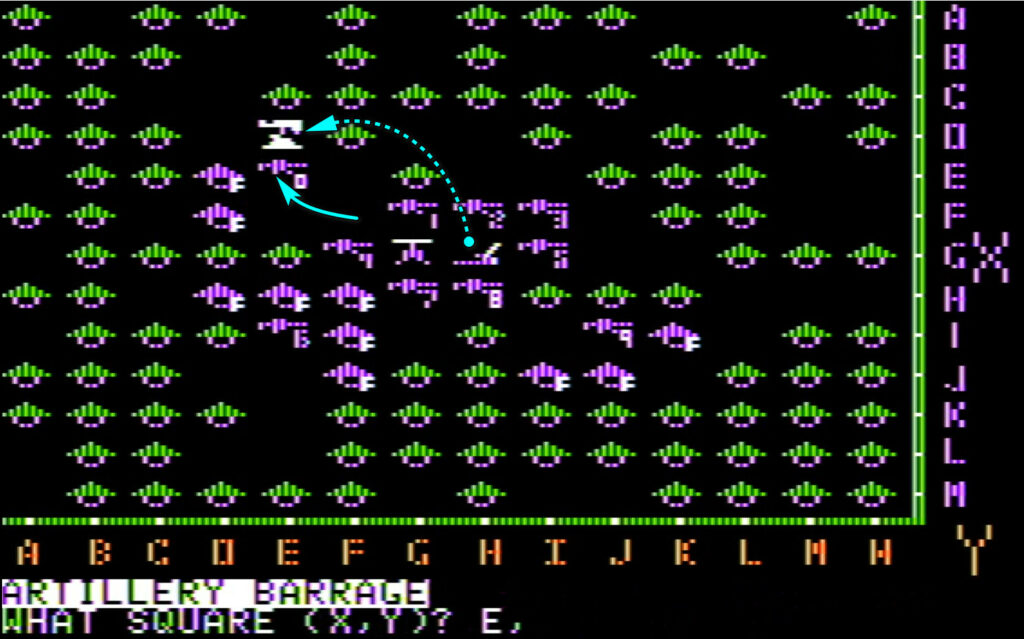
And one turn later, as I see a lot of movement in the far North, I send my airmobile infantry to investigate a little. US infantry cannot turn neutrals into friendly, but it turns out I don’t really need to make friends, as my grunts land in a nest of VC ! They are all destroyed :
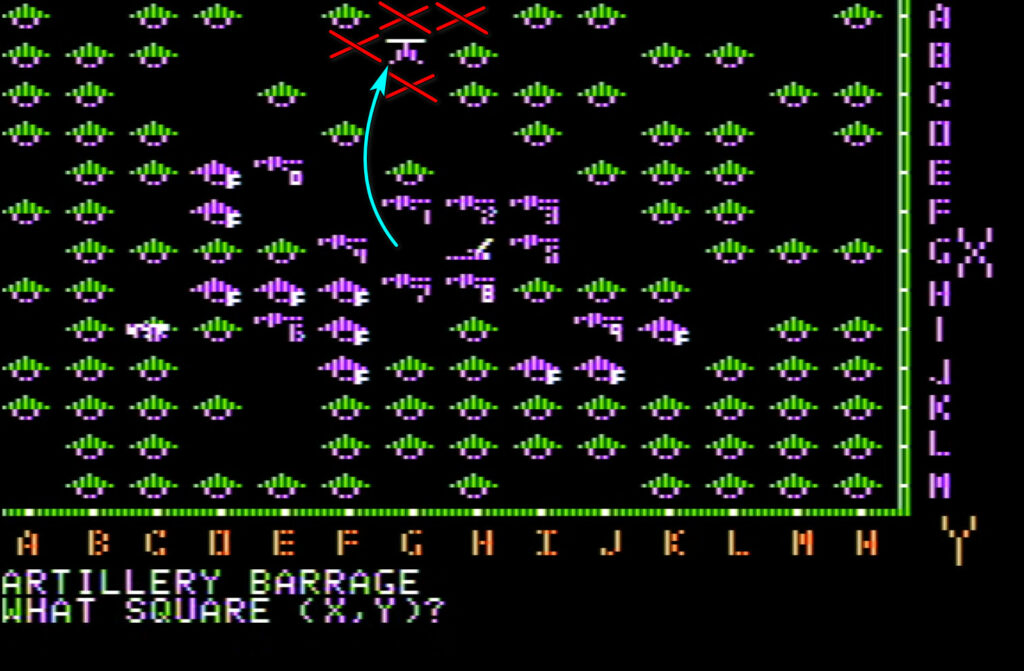
As the game progresses, my objective is to “segment” the civilians into small groups so the Communist ideal cannot spread like a disease among those innocent but naïve civilians. And when I see suspicious movement, my airmobile infantry strikes :

One of my ARNV units finds more NVA infantry in the South-Eastern corner of the map, but this time the latter prevails, and my ARNV is destroyed. The US Airmobile infantry tries to save the day, but it also loses the battle, and takes more losses :
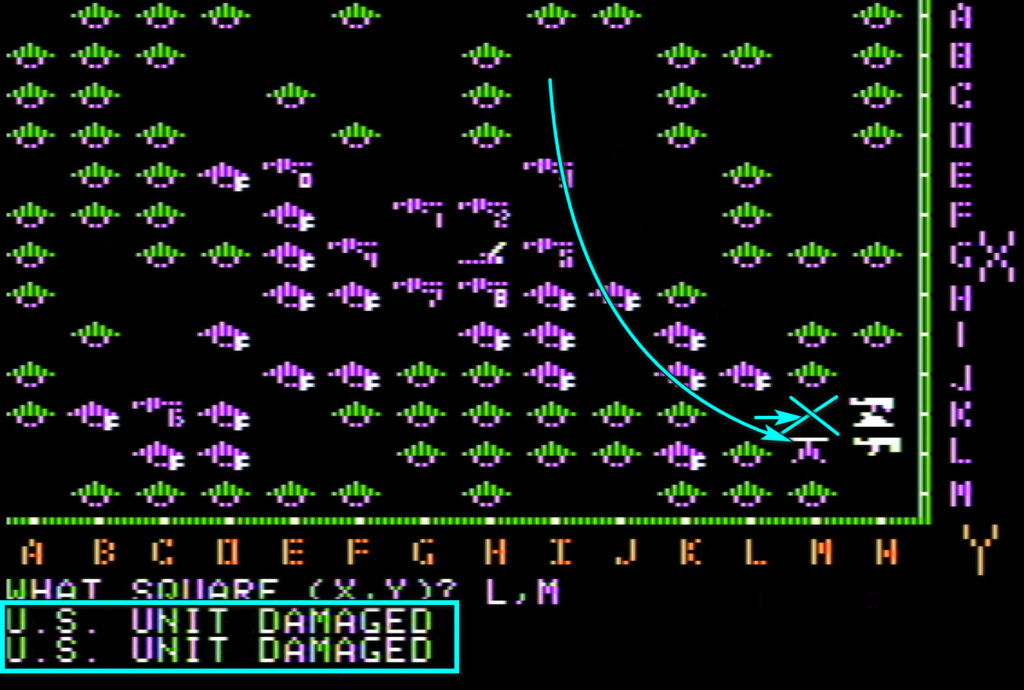
Eventually, my artillery destroys the Northerners and their minions before they can do more damage.
A few turns later, I am pretty happy with my segmentation of the civilian population :
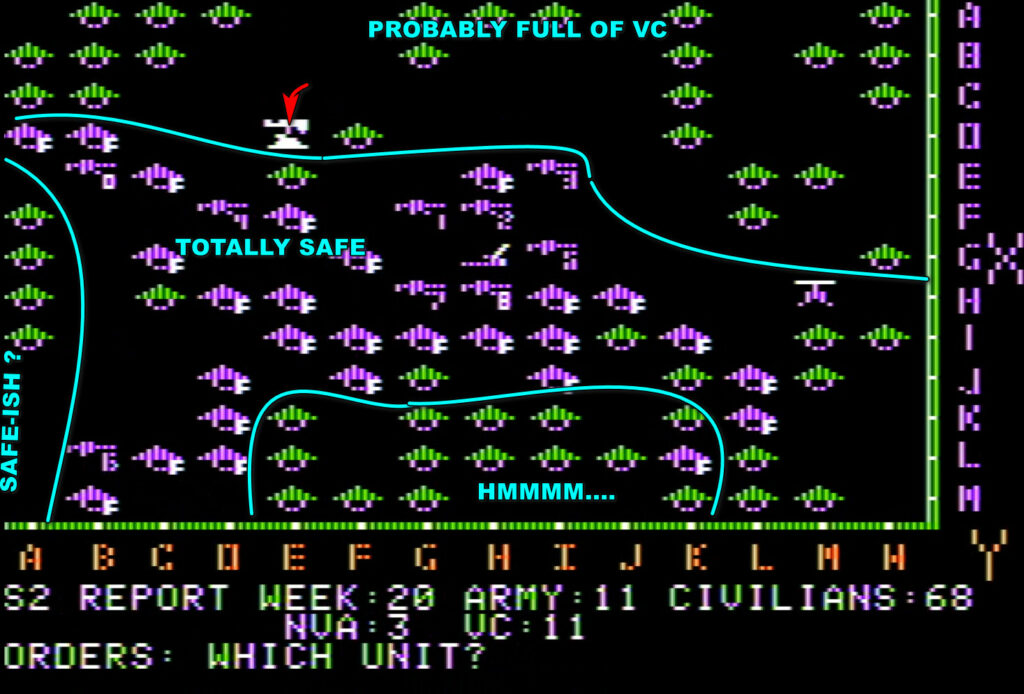
- There are roughly 30 civilians that are either friendly or “safe” (neutral but next to my units),
- North of that group, the destruction of civilians by the VC and counter-destruction of VC by my forces left a large “gap” between the North and the South. I suppose that the North is full of VC and NVA, but at least they cannot contaminate the friendly civilians,
- There is a small group of 4 villagers on the left that should be safe, because they are not moving much,
- Finally, there is this large group at the bottom-middle. If there are VC there, they may spread the horrible virus of national liberation !
As I clear up the group in the North-West and as I kill more Charlies trying to move through the gap, I have a horrible realization :
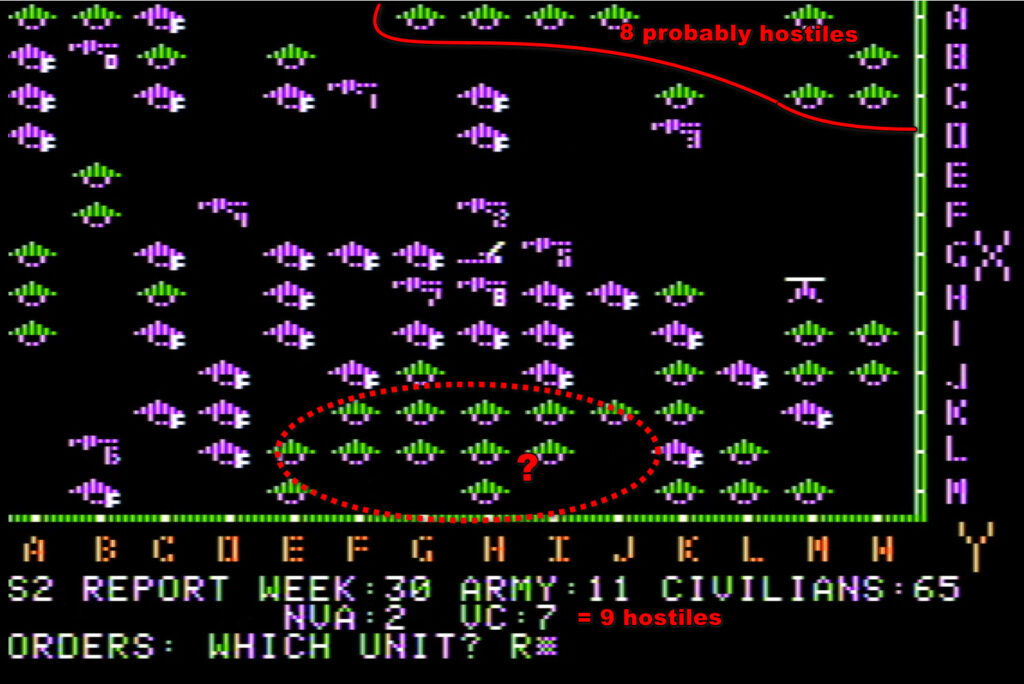
There are 9 VC or NVA left, and only a maximum of 8 in the top-right corner. Some of the VC must be hiding in the South, ready to lunge ideologically at peaceful villagers !
But it turns out the last hidden VC was not where I expected :
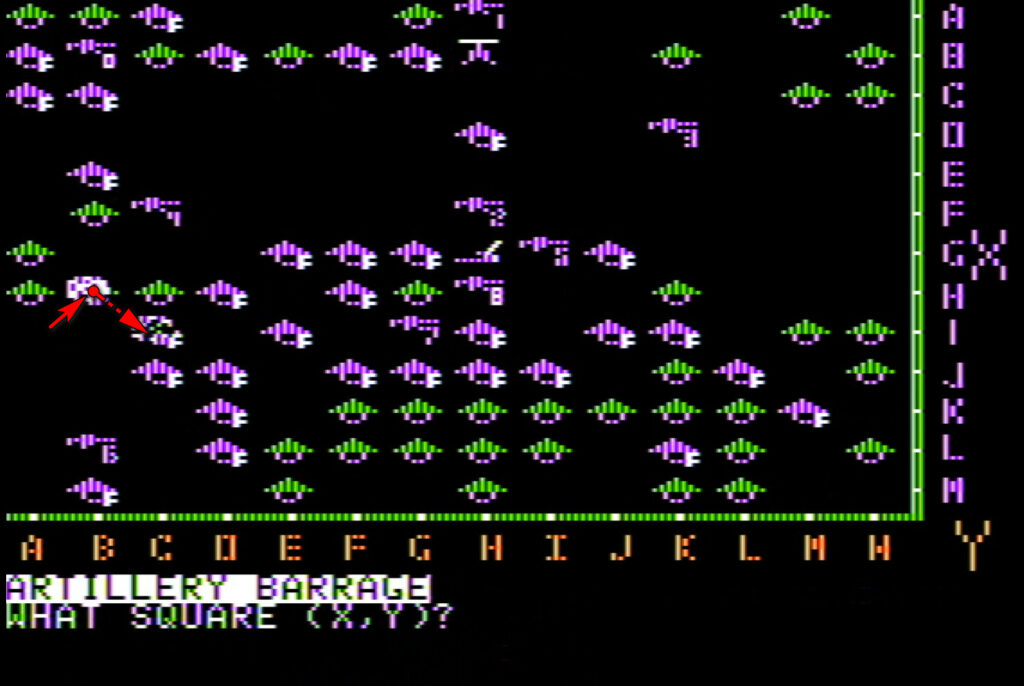
With no dangerous ARNV unit in proximity, I send the Hueys, supported by artillery, once again :
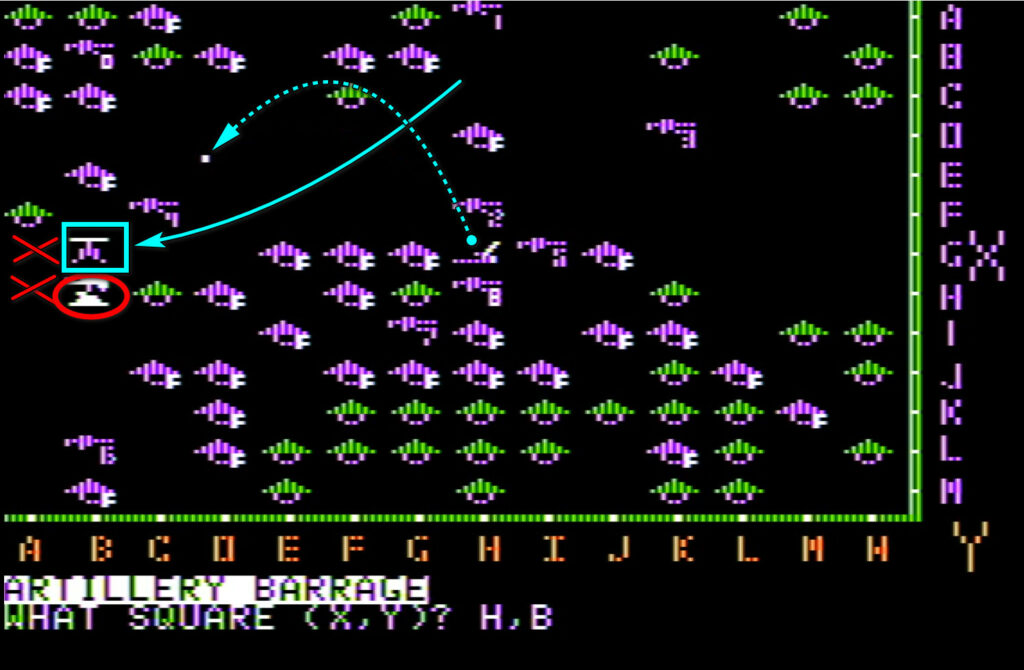
After that, I can finally clear the last remaining Viet-Cong hide-out in the North-East :

I won. But of course what could a bunch of barely trained peasants do against artillery and air power.
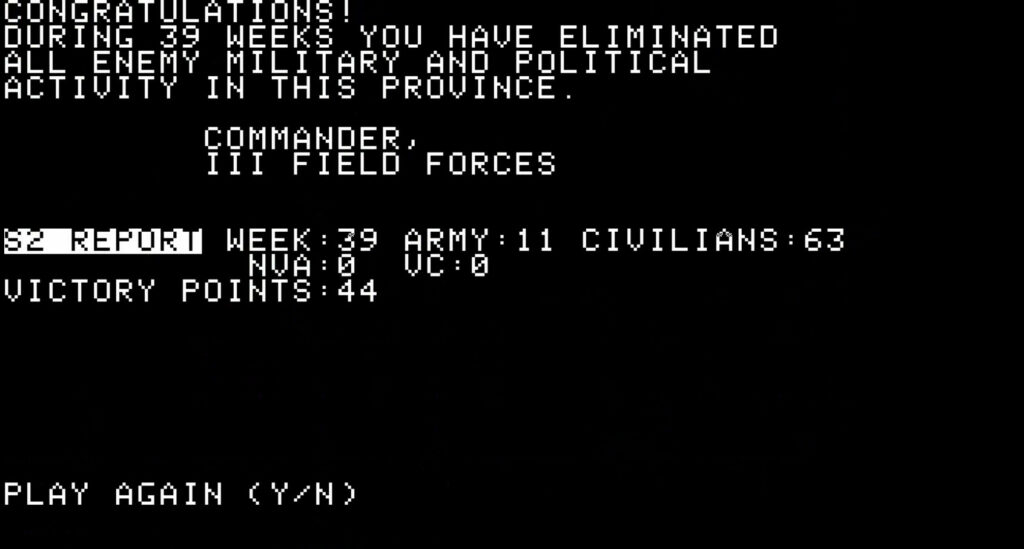
Review and Rating
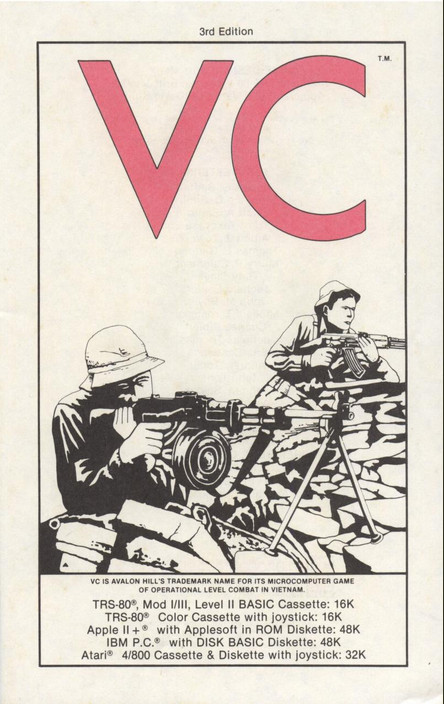
VC by Britt Monk and published by Avalon Hill, USA
First release : Atari 8 bits/Apple II/TRS-80 in Fall 1982
Tested on : Apple II and Atari emulator
Total Hours Tested : 3 hours
Average duration of a battle : 15 minutes.
Complexity : Easy (1/5)
Would recommend to a modern player : You can give it a try !
Would recommend to a designer : No
Final Rating: Interesting
A. Immersion
VC is a simple game with very few moving pieces, but it manages to represent very well the tropes of the Vietnam War, and this well before most Vietnam War movies (Apocalypse Now had been released in 1979, but Platoon is only released in 1986 and Full Metal Jacket in 1987). The game has a firebase, airmobile cavalry, patrols that have to check whether villagers are friendly and hostiles, VC hidden among villagers, NVA and ARVG units.
The game also looks pretty good on Apple II (for 1982), though other versions look much worse :
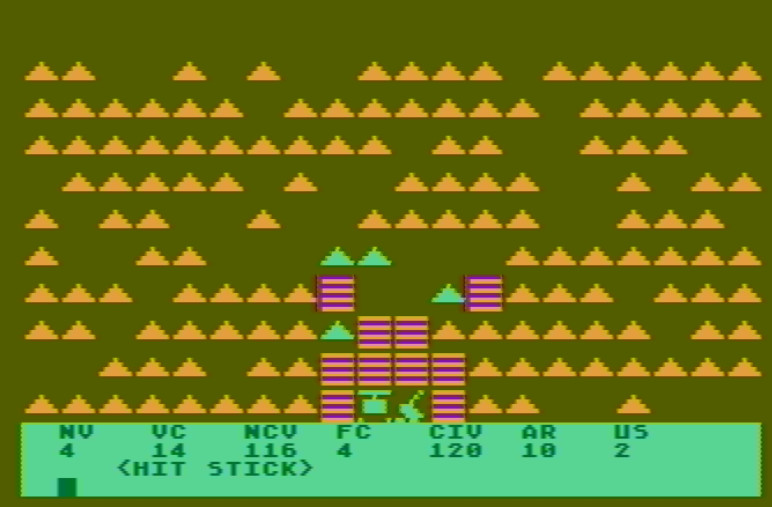
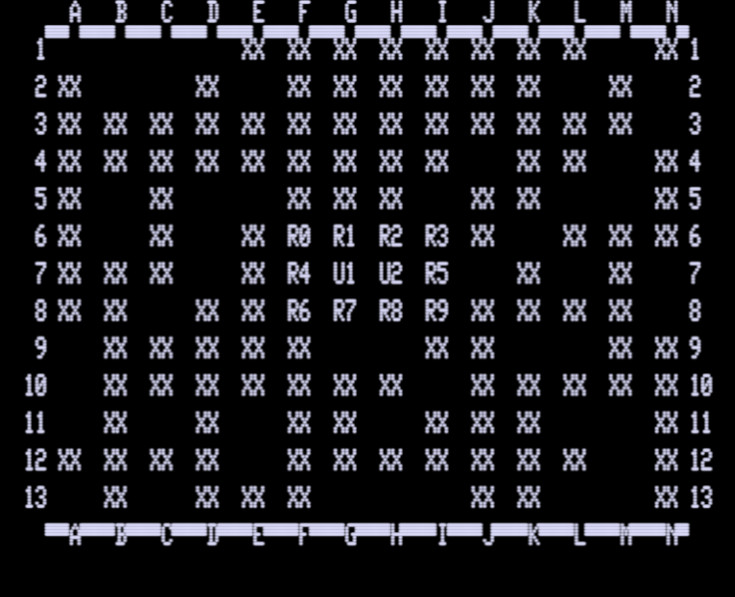
The game has quite a US slant (the VC are killing friendly villagers, the American and South Vietnamese don’t kill hostile villagers but only Vietcongs). There is a four-page “historical background” in the manual, but it is hard for me to distinguish bias, gameplay choices and what historians knew about the conflict in 1982.
Rating : Quite good
B. UI , Clarity of rules and outcomes
The game is very easy to play – which is expected from such a simple game. Commands are given through the keyboard on Apple II and through the joystick on Atari, game rules are clear (not everything is explained, but the game does not need detailed rules on combat). Not much to say really.
Rating : Good. I can’t give a rating above “good” for a game that simple.
C. Systems
I believe I have explained most of them. A few things that may not be clear :
- The player’s turn has two phases :
- One unit is activated,
- Then the player can use artillery once,
The player can decide to activate their artillery instead of moving, in which case they can fire their artillery three times in a row,
- The “computer turn” is actually the movement of 10 randomly picked units on the map, some of them true neutrals, some of them hostiles. Some if not most of these movements are invisible because they are “permutations” of two units that look exactly the same to the player,
- The player wins if they destroy all VC and NRA forces. The players loses if more than half the civilians are killed or join the VC (as the manual says, “you can’t save the country by destroying it“)
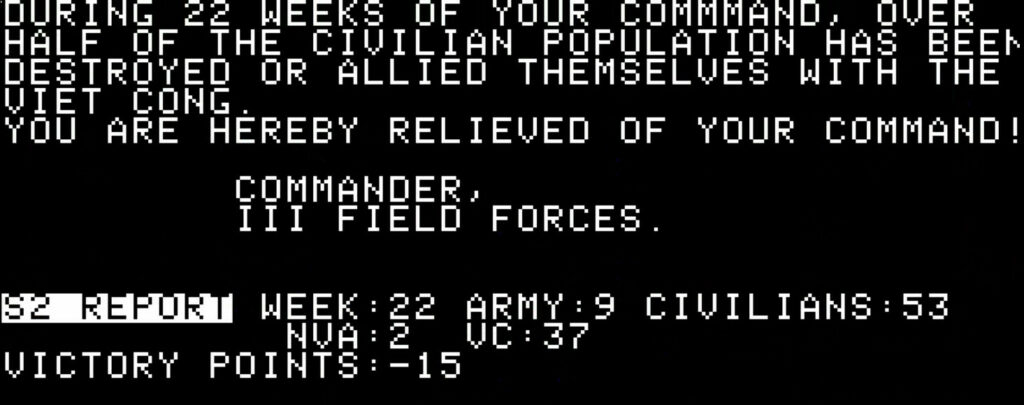
- You can shoot artillery anywhere on the map, including on your own troops, but more importantly on “neutral” civilians. Sometimes, you know they are Vietcongs, for instance because you saw them attack another group of civilians. But if they were indeed neutral, all the “friendly” civilians on the map will turn neutral.
- Vietcongs have terrible combat value and are usually killed instantly, though on rare occasions they get lucky ; NVA and ARVN are equivalent.
The one thing that falls a bit short is that I get to move only one unit by turn, so the game is not really about managing resources but about managing time. The one-unit-by-turn feels artificial and severely limits the number of strategies you can use.
Rating : Quite good.
D. Scenario design & Balancing
The game has only one scenario, with a random distribution of villagers and enemies and varying levels of difficulty (1-4 on Apple II, 1-5 on Atari), though it seems to only change the number of Vietcongs and NRA. There does not seem to be an AI either – the movements of the computer seem “random” ; else I am pretty sure the player would lose almost every single time.
From my limited experience of the game, success or failure depends on the first turns of the game. If there are Vietcongs in the corners of the map and they start moving & recruiting before you can even reach those corners, you will not be able to stall the exponential growth of the VC. If on the other hand the VC don’t grow too much at the beginning and you can quickly secure a chunk of the map with a curtain of ARNV, then victory is possible.
Rating : Poor
E. Did I make interesting decisions
Yes, every turn in the “middle” of the game. Early on, your movements are pretty random as you have no information on the Vietcongs, but by mid-game, you will ask yourself every turn :
- Do I spend one turn trying to destroy a known threat or do I allocate this turn to improve my segmentation of the civilians ?
- If I try to segment the civilians, which ones can I consider safe, and which ones are not ?
- If I try to destroy a threat, should I use the mobile air cavalry, or use an infantry unit, which is more risky and can put it out of position, but allows to befriend civilians ?
F. Final rating
Interesting ! I did not expect it after my earlier Avalon Hill experiences, yet I had a lot of fun with VC. Not always, sometimes it is frustrating as you feel like the dice were cast before your first move. But some other times the challenge is just right and the 15-minute sessions are short enough that they are never dull. It is certainly not a major wargame, it has limited scope and complexity. I see it more as a dynamic puzzle game (much like Into the Breach) than as a wargame, but because it is so simple, it aged much better than more prestigious titles.
Contemporary Review
VC seems to have gone mostly under the radar, though my research has not been helped by the generic name and by Avalon Hill inconsistently calling the game either VC or V.C.
The only review I could find is from Creative Computing (September 1983) ; and it is very positive “Everything the early Avalon Hill games did not have, this game has, including amusing sound effects and smooth animation.” The tour de force is of the game is that “in a way, this game is like the real Vietnam War. Victory seems only a tantalizing step away. You have the men and the firepower, but the more you kill, the more of the enemy there seems to be. […] One thing seems certain, that tantalizing glimpse of a light at the end of the tunnel will bring you back again and again to VC.”
The only other contemporary review is from France. Tilt covers it with many wargames in March 1984, and finds it “very attractive”, giving it 3-stars out of 6 ; a decent grade for early Tilt.
Computer Gaming World did not immediately review VC, but in its later review of all post-WW2 wargames in 1992 it seems to share part of Creative Computing’s opinion that it is very much like the real Vietnam War, but not for the same reason : “almost as enjoyable as the real thing, i.e., not very.” In my opinion, a real harsh review just to throw in a joke. If you like puzzle games with a military theme, give it a try and report !
4 Comments
Are those troops jumping out of a National Geographic helicopter in the intro photo? ^^
Either way, nice article. Funny that Tilt doesn’t appear to have given ANY game a higher rating than 3/6 – darned Frenchmen!
They gave 6/6 to whatever Roger Keating produced :).
But yes, in general, French people tend to rate everything between “meh” and “not bad”. I still have fond memories of this US International student who received a 14/20 in my University, for which she was congratulated because that was a great grade, but for her a naive and linear conversion meant she had received a B- or a C+ and that would look horrible on her curriculum.
Later, the French magazines would start running a lot more ads for those American games and the average grades would go up, until this era when Generation 4 would rate almost everything between 90% and 100%.
Curious readers may want to look at Chronologically Gaming, who covered the difference between the Apple II, Color Computer and TRS-80 versions:
The Color Computer version had slick controls, clearly.
Just wanted to thank you for covering these “not quite wargames” as well. I’m not really a wargamer, things like Eastern Front are not for me, but I love trying out those smaller games that live on the fringes.
Spent some fun times with VC, and it’s fascinating how it has this very mechanical, game-y structure that nevertheless captures some of the nature of that conflict.